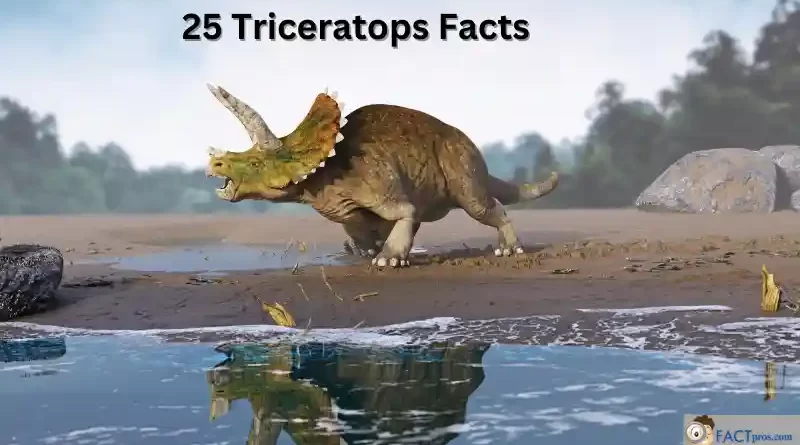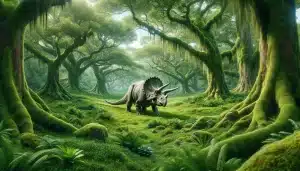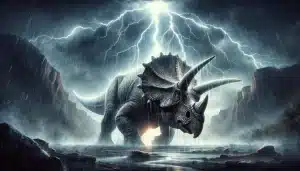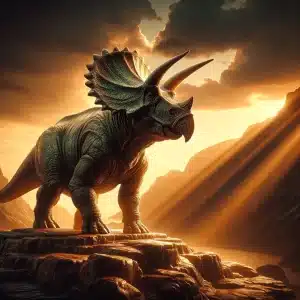25 Triceratops Facts: Unveiling the Mysteries of the Horned Dinosaur
Dinosaurs have long captured the imagination of both young and old alike. Among these prehistoric giants, Triceratops stands out as one of the most iconic and fascinating. With its distinctive frill and three facial horns, Triceratops is a dinosaur that has left a lasting impression on popular culture and paleontology. In this article, we’ll delve deep into the world of Triceratops and unveil 25 intriguing facts about this remarkable horned dinosaur.
Quick Tips:
- Look for facts about Triceratops’ physical features, habitat, and diet.
- Discover the latest research findings on this iconic dinosaur.
- Learn about its significance in the world of paleontology.
25 facts and Traits about Triceratops:
From its iconic three horns to its plant-eating habits, each characteristic tells a story of survival and evolution. Let’s dive into the details that make the Triceratops so extraordinary.
Triceratops Traits Table
| # | Trait | Description |
|---|---|---|
| 1 | Name Origin | “Triceratops” means “three-horned face” in Greek. |
| 2 | Era | Lived during the Late Cretaceous, 68-66 million years ago. |
| 3 | Size | Up to 30 feet long, weighing several tons. |
| 4 | Horns | Three facial horns – two above the eyes, one on the nose. |
| 5 | Frill | Bony frill at the back of the head. |
| 6 | Diet | Herbivore, feeding on plants. |
| 7 | Beak | Adapted for cropping and grinding tough vegetation. |
| 8 | Fossil Location | Mainly found in North America. |
| 9 | Family | Part of the Ceratopsidae family. |
| 10 | Social Behavior | Possible herd living for protection. |
| 11 | Defense | Used horns and frills against predators. |
| 12 | Reproduction | Details largely unknown. |
| 13 | Extinction | Perished in the K-Pg extinction event. |
| 14 | Impact Hypothesis | Extinction possibly caused by asteroid impact. |
| 15 | Cultural Significance | A cultural icon in media. |
| 16 | Ongoing Research | Continuously studied by paleontologists. |
| 17 | Nasal Horn | Shorter than brow horns, different functions. |
| 18 | Frill Variation | Distinct patterns for identification. |
| 19 | Teeth and Jaws | Adapted for processing plants. |
| 20 | Relative | Closely related to Torosaurus. |
| 21 | Limbs | Shorter front limbs. |
| 22 | Movement | Capable of bipedal and quadrupedal motion. |
| 23 | Nests | Evidence of nest building. |
| 24 | Species Diversity | Multiple species identified. |
| 25 | Educational Role | Used in educational exhibits and museums. |
Table Summary
The Triceratops, a giant of the Late Cretaceous, was much more than just its three horns. From its massive size to its dietary habits, every aspect of this dinosaur showcases an evolutionary marvel. The ongoing discoveries and studies continue to shed light on its life and role in prehistoric ecosystems, making it a perennial subject of fascination and education. 🦖🌿
These 25 facts comprehensively overview Triceratops and its significance in paleontology and popular culture.
Myth vs Reality: Triceratops Edition 🦕
Lets dive into the world of the mighty Triceratops and separate fact from fiction. It’s like a detective story, but with dinosaurs!
1. Myth: Triceratops Was a Lone Wolf
Reality: Some think Triceratops was a solo act, but evidence suggests they might have been social, living in herds. Imagine a group of these horned giants hanging out together!
2. Myth: Triceratops and Tyrannosaurus Rex Were Sworn Enemies
Reality: While it’s a popular scene in movies, it’s not clear if T. Rex and Triceratops had regular showdowns. Sure, they lived at the same time, but whether they constantly battled is still up for debate.
3. Myth: Triceratops Was Slow and Cumbersome
Reality: Despite its massive size, Triceratops could probably move quite briskly when needed. Those powerful legs weren’t just for show!
4. Myth: Triceratops Used Its Horns Only for Fighting
Reality: Those iconic horns were likely multi-purpose tools – for defense, yes, but also possibly for attracting mates or even digging up plants. Who knew?
5. Myth: All Triceratops Looked the Same
Reality: Not all Triceratops were cookie-cutter copies. They had variations in their frill patterns, almost like a dinosaur fingerprint!
6. Myth: Triceratops Was Always a Star in Paleontology
Reality: Triceratops wasn’t always the superstar it is today. It rose to fame after its initial discovery in the late 1800s. Talk about a late bloomer!
7. Myth: Triceratops’ Main Threat Was Other Dinosaurs
Reality: While dinos like T. Rex posed a threat, Triceratops’ ultimate downfall was the Cretaceous-Paleogene extinction event. An asteroid, not a predator, was the likely culprit.
So, there you have it! The Triceratops, a creature of myth and reality, always ready to surprise us. Remember, in the world of paleontology, things aren’t always as they seem!
The Discovery of Triceratops
Triceratops was only sometimes a household name. Its recognition began with a remarkable discovery. The first Triceratops fossils were discovered in the western United States in the late 1800s. It is impossible to overestimate how important this revelation is to understanding prehistoric life.
The name “Triceratops,” though it may sound familiar to you, was chosen through a scientific naming procedure. The word, which means “three-horned face” in Greek, perfectly describes the dinosaur’s most distinctive feature.
Triceratops Classification
Understanding where Triceratops fits into the grand scheme of the dinosaur family tree is crucial. Triceratops is part of the Ceratopsidae family, which includes other horned dinosaurs like Styracosaurus and Chasmosaurus. These creatures were characterized by their unique frills and facial adornments. Next lets look at the physical characteristics and habitat.
Extinction
One of the most intriguing questions surrounding Triceratops is why it and other dinosaurs met its end in the Cretaceous-Paleogene (K-Pg) extinction event. Theories abound, including the impact hypothesis, which suggests that a massive asteroid impact led to drastic environmental changes, ultimately spelling doom for these magnificent creatures.
Cultural Significance
Beyond the realm of paleontology, Triceratops has significantly impacted popular culture. Its iconic appearance has graced the pages of countless books, adorned the screens of movies and documentaries, and even found its way into toys and video games. The allure of Triceratops continues to captivate the imaginations of generations.
Ongoing Research
The world of paleontology is ever-evolving, and Triceratops remains a subject of active research. Discoveries and technological advancements continually expand our understanding of this horned dinosaur and the prehistoric world it inhabited. Stay tuned for exciting developments in the field.
Table 1: Triceratops Anatomy and Characteristics
| Feature | Description |
| Classification | Genus: Triceratops<br>Family: Ceratopsidae |
| Period | Late Cretaceous (68-66 million years ago) |
| Length | Up to 30 feet (9 meters) |
| Weight | Several tons |
| Horns | Three facial horns: Two brow horns, one nasal horn |
| Frill | Bony neck frill with unique patterns |
| Diet | Herbivorous, primarily consuming plants |
| Teeth | Dental batteries adapted for grinding vegetation |
| Limb Structure | Short front limbs, massive hind limbs |
| Locomotion | Bipedal (two-legged) and quadrupedal (four-legged) |
| Social Behavior | Potential herding behavior, but not fully confirmed |
| Defensive Mechanisms | Use of horns and frill for defense |
| Reproduction | Limited knowledge of nesting and offspring |
| Extinction | Disappeared during the Cretaceous-Paleogene event |
| Fossil Discoveries | Mainly in North America, including Montana and Wyoming |
| Scientific Significance | Iconic ceratopsid dinosaur with rich fossil record |
| Taxonomic Variations | Different species and individual variations |
| Environmental Context | Lush Late Cretaceous forests and plant life |
| Predators | Potential predators included large theropods |
| Cultural Impact | Prominent in popular culture, from books to movies |
| Ongoing Research | Active research in paleontology continues |
| Ancestral Relationships | Closely related to Torosaurus within ceratopsids |
| Unique Nasal Horn | Nasal horn shorter than brow horns, purpose debated |
This table provides a detailed overview of Triceratops’ anatomy, characteristics, and place in paleontology and natural history.
Conclusion
In the grand tapestry of Earth’s history, Triceratops occupies a unique and enduring place. It’s a dinosaur that has made a lasting impression on the scientific community and popular culture with its characteristic horns, frills, and massive stature. We learn more about the fantastic range of life that once walked our world during the Age of Dinosaurs as we continue to solve the mystery surrounding Triceratops.
Therefore, remember the vast array of information and findings that make this horned dinosaur a genuine marvel of natural history the next time you see a photograph of a triceratops.
FAQ
Triceratops is singular and triceratopses is plural
It’s a popular movie scene, but there’s no definitive evidence that T. Rex and Triceratops had frequent battles.
Despite their size, Triceratops could likely move quite briskly, thanks to their strong legs.
Triceratops’ horns were likely used for multiple purposes: defense, attracting mates, and maybe even digging.
No, there were variations among Triceratops, especially in their frill patterns, making each one somewhat unique.




